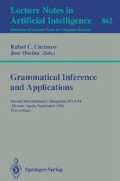Abstract
We present an algorithm that acquires words (pairings of phonological forms and semantic representations) from larger utterances of unsegmented phoneme sequences and semantic representations. The algorithm maintains from utterance to utterance only a single coherent dictionary, and learns in the presence of homonymy, synonymy, and noise. Test results over a corpus of utterances generated from the Childes database of mother-child interactions are presented.
Preview
Unable to display preview. Download preview PDF.
References
J. Bachenko and E. Fitzpatrick. 1990. “A Computational Grammar of Discourse-Neutral Prosodic Phrasing in English,” Computational linguistics 16, 3, 155–170.
S. Carey. 1978. The Child as a Word Learner. In M. Halle, J. Bresnan and G. Miller (eds), Linguistic Theory and Psychological Reality. M.I.T. Press, Cambridge, Massachussets.
T. Cartwright and M. Brent. 1994. Segmenting Speech Without a Lexicon: Evidence for a Bootstrapping Model of Lexical Acquisition, in Proceedings of the 16th Conference of the Cognitive Science Society, 1994.
K. Church 1987. “Phonological parsing and lexical retrieval,” Cognition, 25:53–69
A. P. Dempster and N. M. Laird and D. B. Rubin. 1977. “Maximum Likelihood from Incomplete Data via the EM Algorithm” Journal of the Royal Statistical Society, B 39, 1–38.
R. Jackendoff. 1990. Semantic Structures. M.I.T. Press, Cambridge, Massachussets.
B. MacWhinney and C. Snow. 1985. “The Child Language Data Exchange System,” Journal of Child Language 12, 271–296.
D. Olivier. 1968. Stochastic Grammars and Language Acquisition Mechanisms. PhD thesis, Harvard University, Cambridge, Massachusetts.
J. Rissanen. 1978. “Modeling by shortest data description,” Automatica 14, 456–471.
J. Siskind. 1992. Naive Physics, Event Perception, Lexical Semantics, and Language Acquisition. PhD thesis, Massachusetts Institute of Technology, Cambridge, Massachusetts.
J. Siskind. 1993. Lexical Acquisition as Constraint Satisfaction. Technical Report IRCS-93-41, University of Pennsylvania Institute for Research in Cognitive Science.
J. Siskind. 1994. Lexical Acquisition in the Presence of Noise and Homonymy. In Proceedings of the 12th National Conferance on Artificial Intelligence (AAAI-94).
P. Suppes. 1973. “The semantics of children's language,” American Psychologist.
Author information
Authors and Affiliations
Editor information
Rights and permissions
Copyright information
© 1994 Springer-Verlag Berlin Heidelberg
About this paper
Cite this paper
de Marcken, C. (1994). The acquisition of a lexicon from paired phoneme sequences and semantic representations. In: Carrasco, R.C., Oncina, J. (eds) Grammatical Inference and Applications. ICGI 1994. Lecture Notes in Computer Science, vol 862. Springer, Berlin, Heidelberg. https://doi.org/10.1007/3-540-58473-0_138
Download citation
DOI: https://doi.org/10.1007/3-540-58473-0_138
Published:
Publisher Name: Springer, Berlin, Heidelberg
Print ISBN: 978-3-540-58473-5
Online ISBN: 978-3-540-48985-6
eBook Packages: Springer Book Archive

